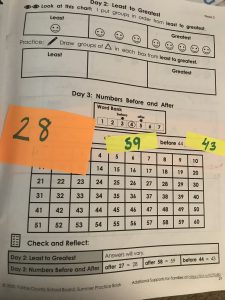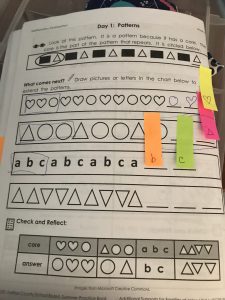 As a result of the COVID school closures, Joey’s school district sent home summer learning packets for every student. Every kindergartener in the whole district received the same packet of kindergarten practice work to keep their skills fresh over the summer. While I watched my own daughter do this packet one morning I realized that it would not be hard for Joey to work on this same packet – as long as someone was there to physically adapt it for him.
As a result of the COVID school closures, Joey’s school district sent home summer learning packets for every student. Every kindergartener in the whole district received the same packet of kindergarten practice work to keep their skills fresh over the summer. While I watched my own daughter do this packet one morning I realized that it would not be hard for Joey to work on this same packet – as long as someone was there to physically adapt it for him.
Sometimes we can catch ourselves assuming children cannot access the grade level materials for a variety of reasons and so we do not even bother to show it to them. Joey cannot write down the answers, nor can he run around his house and count how many door frames he sees. Yet if we hold the packet straight up and down, if we draw his eye gaze to the correct places on the page, and if we provide him with a series of multiple choice answers he is able to select from – then he is able to complete some of the work.
To be honest, I was not 100% sure how this would go. I’m always up for trying anything, but some of the concepts seemed like they may be complex and not simply asking him to count and record his answers. Each week there is a “splat” problem. There is a paint “splat” on the page and the directions say that under the splat are some dots – it then gives parameters for those dots – there are more than 6 but less than 10, or more than 9 but less than 18. The child is supposed to generate a few numbers that could be under the splat, relying on their knowledge of less than and more than.
 To do this, I realized, Joey first had to buy into the idea that there were imaginary numbers hidden under the black mark on his page. In kindergarten, I always liked to teach this as “bears in a cave.” You take a set amount of bear manipulatives and place them under a bowl. “How many bears are in the cave?” You can provide the same parameters, but there are actual bears hiding under the bowl. The kindergartener is dying for you to pick up the bowl and actually count the colorful bears. This black and white worksheet instead asks the child to accept that there are imaginary dots. I wasn’t sure Joey would follow that, let alone follow the more and less vocabulary.
To do this, I realized, Joey first had to buy into the idea that there were imaginary numbers hidden under the black mark on his page. In kindergarten, I always liked to teach this as “bears in a cave.” You take a set amount of bear manipulatives and place them under a bowl. “How many bears are in the cave?” You can provide the same parameters, but there are actual bears hiding under the bowl. The kindergartener is dying for you to pick up the bowl and actually count the colorful bears. This black and white worksheet instead asks the child to accept that there are imaginary dots. I wasn’t sure Joey would follow that, let alone follow the more and less vocabulary.
There I go underestimating him again. When offered multiple choices in a visual field he selects a possible right answer about 90% of the time.
 At first, Joey was using different visuals provided to indicate his answers and I was physically writing the answers down. But that was my handwriting on Joey’s book, which somehow did not show it was his. Instead, we transitioned to using those small sticky note tabs. I write possible answers on the tabs and allow Joey to select the correct tab. Then we can stick the answer he chose right onto the document – making it more meaningful and cutting out my need to scribe.
At first, Joey was using different visuals provided to indicate his answers and I was physically writing the answers down. But that was my handwriting on Joey’s book, which somehow did not show it was his. Instead, we transitioned to using those small sticky note tabs. I write possible answers on the tabs and allow Joey to select the correct tab. Then we can stick the answer he chose right onto the document – making it more meaningful and cutting out my need to scribe.
It has been fun watching Joey do the same work each day that my own rising first grader is doing. It makes me wonder what else this next virtual school year may hold for Joey as he accesses grade level materials from his home.


